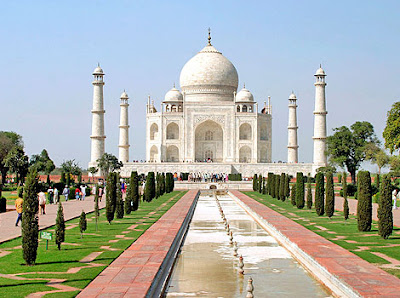
As soon as Bollywood star Bipasha Basu exclaimed "Oh my god, it's the Taj Mahal!" in Lisbon, millions of eager Indians who had been glued to their TV sets in the early hours on Sunday watching the function jumped in joy as the 17th century monument of love was selected among a list of new Seven Wonders of the World.
There was much hugging and "congratulations", bursting of firecrackers and distribution of sweets after the Taj was named at a star-studded function in Benfica Stadium, Lisbon, Portugal. It was attended by several celebrities including actors Ben Kingsley and Hilary Swank.
"You just cannot believe, how happy I am today. I had voted through all possible means for our Taj, and it has finally made it," said an excited Hariom Satpathy of Delhi.
"I was almost hooked to the TV since 10 pm on Saturday night till the result was declared at around 3 am today. I called my friends and relatives to give them the news. At home, we exchanged sweets and fire crackers," Satpathy added.
The seven wonders list was compiled through a global poll participated in by at least 100 million votes casted through Internet, telephone and SMS campaign.
Apart from the Taj Mahal, the others are, the Great Wall of China, Brazil's Statue of Christ the Redeemer, Peru's Machu Picchu Inca trail, Mexico's Chichen Itza pyramid, Jordan's Petra archaeological site and the Colosseum in Rome were declared as winners.
Agra Mayor Anjula Singh received the honours from actors Ben Kingsley and Bipasha Basu at the glittering event in Lisbon.
Mushirul Hasan, noted historian and vice chancellor of Jamia Milia Islamia university in the Indian capital, said that he was really elated over the news.
"It's certainly one of the best news for India. Taj is a symbol of our glorious heritage, of love and unparalleled architecture. We should celebrate the occasion," Hasan told IANS.
In Agra, the home of the Taj Mahal, a white marble monument constructed by Mughal emperor Shah Jahan in memory of his wife Mumtaz Mahal, it was festivity time. Motorcyclists took off to the roads, while others got busy bursting firecrackers and distributing sweets to passers by.
Agra's municipal commissioner Shyam Singh Yadav told IANS: "It is a great psychological boost. I am very happy. Agra will now get wide publicity all over the world and many more people will come to see the Taj Mahal which represents India's cultural unity."
Although UNESCO has categorically denied its involvement with the contest, which many leading historians and citizens' groups have called phoney, for the Agra folks it is a matter of pride.
"Agra-ites voted with full enthusiasm till the last minute," said Amit Agarwal, an IT professional who himself voted 10 times.
A private body called the New7Wonders Foundation carried out the global campaign. Initially, the campaign, which started in 1999, included 77 monuments from around the globe and was then shortened to 21 in January 2006. The final list of seven wonders was declared based on the popular vote received.
India's Tourism and Culture Minister Ambika Soni had said last month that elevation of Taj to the new seven wonders list would "boost tourism in the country".
Tourism industry leaders are upbeat too. Arun Dang, former president of the Tourism Guild, said: "The result will see a boom in tourism and Agra is sure to benefit."
A visibly pleased Shekhar, a student of St Peter's College in Agra, said: "Taj is Taj. If we had been indifferent to the contest we would have lost the race. But students groups and youngsters were right in the forefront in Agra in voting. We feel confident the new recognition will help the city."
Sushil Sitapuri, a Lucknow-based writer who recently brought out a special volume on the Taj Mahal, told IANS: "The Taj Mahal is a jewel, like Kohinoor. It is the shaan (pride) of the whole of India. Former US president Bill Clinton said there were two groups of people in the world - one, those who had seen the Taj, and others, those who had not seen the Taj. It is very exciting news indeed."
Rakesh Chauhan of the Hotels and Restaurant Association of Agra said the results had come at the right time when much was happening in the city and the Commonwealth Games were to be held in three years.
Poulomi Saxena, an advertisement professional in Jaipur, Rajasthan, said that the declaration would certainly bring in more foreign tourists to India.
"There was no doubt about the beauty of Taj and it's standing as a tourist attraction site. But its place in the new seven wonders list would certainly generate a lot of awareness among people across the globe and attract them to India," Saxena added.
The seven wonders declared late on Saturday night beat 14 others renowned landmarks including Eiffel Tower of France, the Statue of Liberty of the US and the Acropolis of Greece and Sydney Opera House, Australia.
Source: hindustantimes




